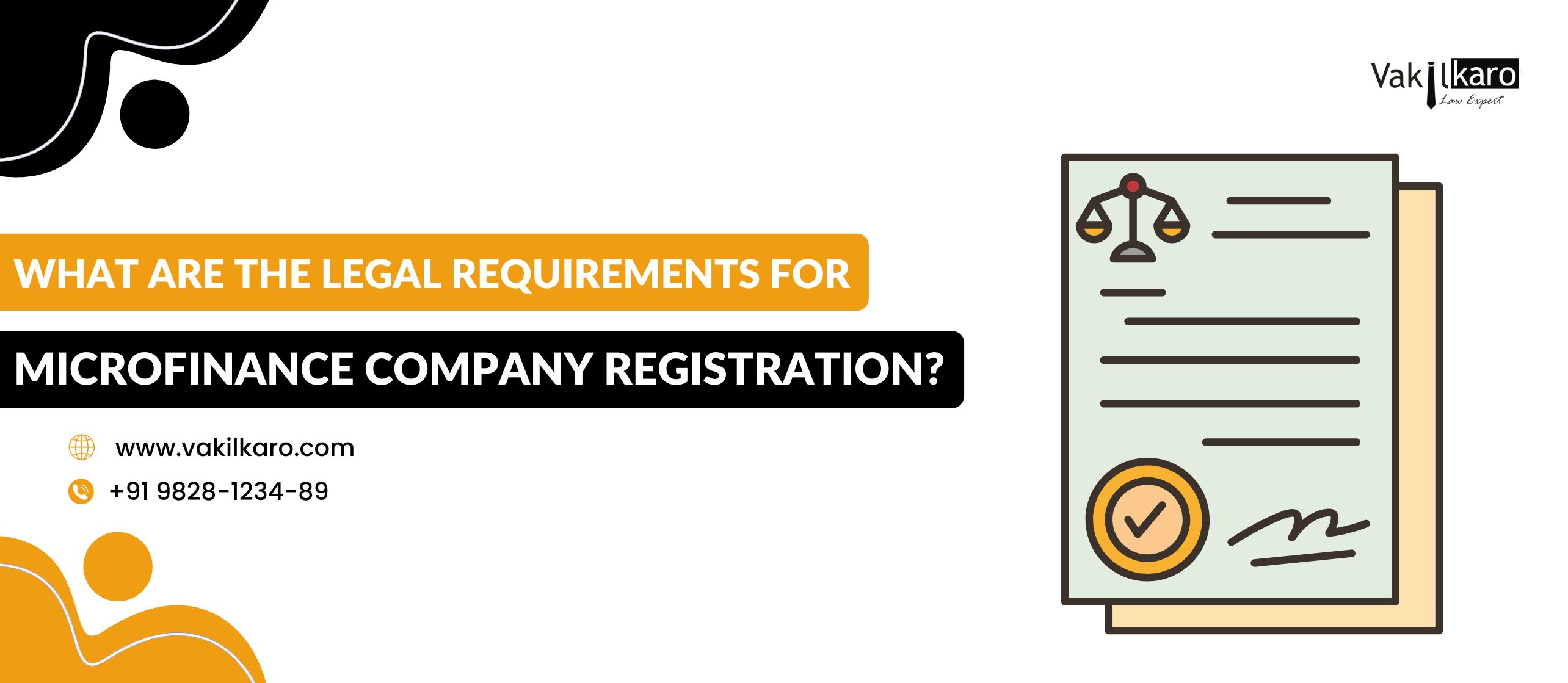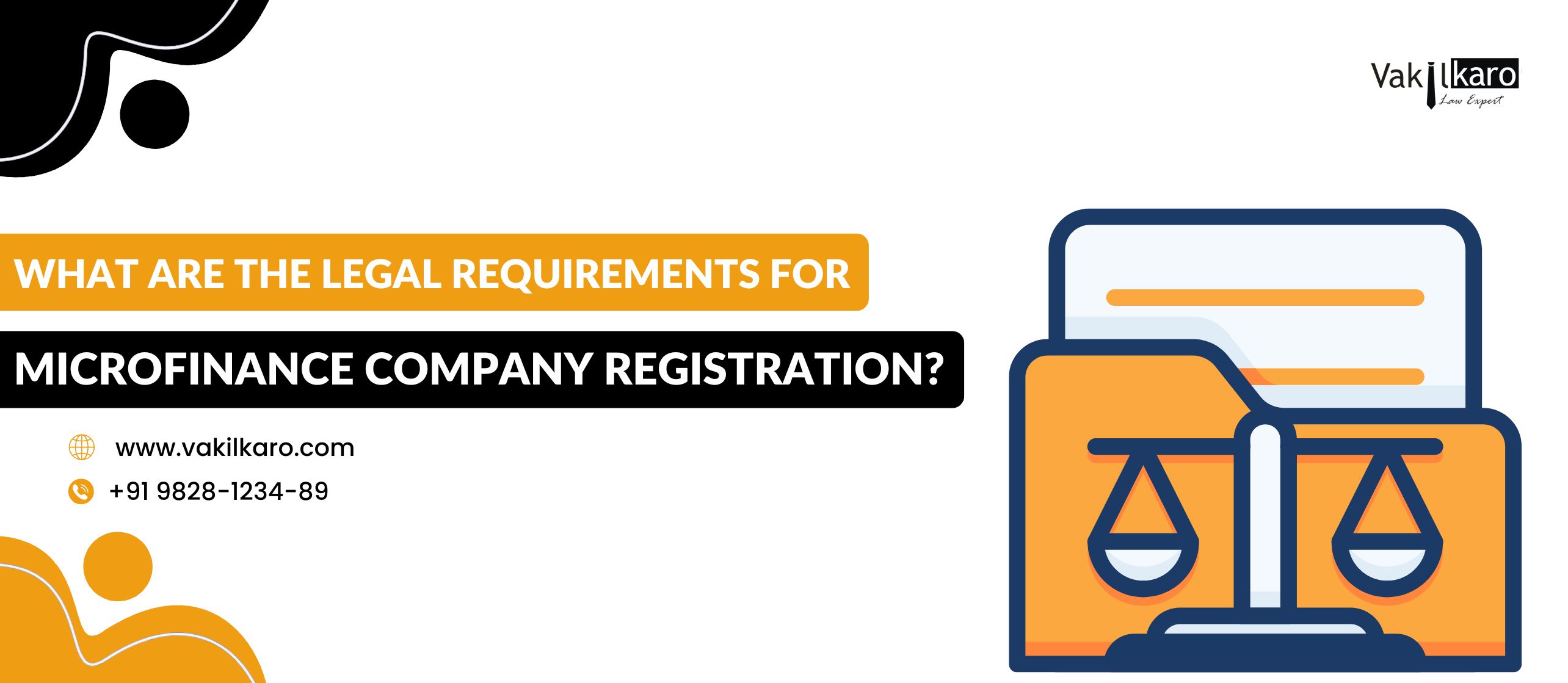Legal Requirements for Microfinance Company Registration
Microfinance companies play a crucial role in offering financial assistance to small businesses, low-income groups, and rural communities that lack access to traditional banking services. To operate legally and gain credibility, microfinance company registration is essential. Before starting the registration process, it is important to understand the different types of microfinance institutions (MFIs) in India. These include NBFC-MFIs, societies, trusts, cooperative societies, and Section 8 companies. Among these, Section 8 microfinance companies are a preferred choice due to their lower compliance requirements and exemption from RBI approval for deposit acceptance.
The registration process involves several legal steps. Businesses must first choose an appropriate structure, with Section 8 companies and NBFC-MFIs being the most common options. Microfinance registration also requires compliance with capital requirements—while NBFC-MFIs must maintain a minimum capital of ₹5 crore (₹2 crore for the Northeast region), Section 8 microfinance companies have no such mandatory capital requirement but must ensure financial sustainability. Other key legal steps include selecting a company name, obtaining approval from the Ministry of Corporate Affairs (MCA), and completing tax registrations like PAN and TAN.
For NBFC-MFIs, obtaining an RBI Certificate of Registration (CoR) is mandatory. This process includes submitting financial projections, a business plan, and compliance documents. Additionally, microfinance companies must adhere to interest rate regulations and ensure proper legal documentation for lending operations.
One major advantage of opting for Section 8 microfinance company registration is its cost-effectiveness. The Section 8 microfinance company registration fees are significantly lower than those of an NBFC-MFI, making it a viable option for social enterprises. Choosing the right structure and following legal compliance ensures smooth operations and long-term sustainability in the microfinance sector.

Introduction
Microfinance companies serve as a critical financial bridge for small businesses, low-income individuals, and rural communities that lack access to traditional banking services. These institutions provide small loans, credit facilities, savings opportunities, and other essential financial services to help marginalized sections of society achieve economic stability and independence. Since mainstream banks often impose strict eligibility criteria and collateral requirements, microfinance companies enable financial inclusion by offering accessible and affordable credit solutions.
To operate legally and efficiently, microfinance company registration is a crucial step. Registration ensures compliance with regulatory authorities and establishes the company’s credibility, making it eligible for funding, government grants, and partnerships. Whether you are starting a new microfinance institution or transforming an existing entity into a formal microfinance company, understanding the legal requirements is essential. The registration process varies depending on the type of microfinance entity, such as NBFC-MFI, Section 8 company, cooperative society, trust, or society. Each category has different compliance obligations, capital requirements, and regulatory approvals.
One of the most common choices for microfinance institutions is registering as a Section 8 company, which allows operations as a non-profit entity with reduced compliance requirements. Unlike NBFC-MFIs, Section 8 microfinance companies do not require RBI approval for deposit acceptance, making them a cost-effective and straightforward option. However, they must still adhere to legal formalities, including obtaining necessary licenses, tax registrations, and ensuring compliance with financial regulations.
This blog will explore the legal framework governing microfinance institutions, the step-by-step registration process, compliance obligations, and Section 8 microfinance company registration fees to help entrepreneurs and organizations navigate the process efficiently. Understanding these aspects is essential for ensuring smooth operations and long-term sustainability in the microfinance sector.
Types of Microfinance Companies in India
Before delving into microfinance registration, it is important to understand the different types of microfinance institutions (MFIs) in India:
- Non-Banking Financial Company – Microfinance Institution (NBFC-MFI): Registered under RBI regulations and provides financial services to low-income groups.
- Society Registration: Operates under the Society Registration Act, 1860, providing micro-loans with limited scope.
- Trust Registration: Registered under the Indian Trust Act, primarily working for social welfare.
- Cooperative Society Registration: Formed under the Cooperative Societies Act, offering financial assistance within a specific community.
- Section 8 Company (Non-Profit MFI): Registered under the Companies Act, 2013 offering financial services without profit motives.
Among these, Section 8 microfinance company registration is popular due to its ease of compliance and exemption from RBI approval for accepting deposits.
Legal Requirements for Microfinance Company Registration
To successfully register a microfinance company, businesses must comply with specific legal requirements:
1. Business Structure and Registration
The first step in microfinance company registration is selecting the appropriate legal structure. The most common structure for MFIs is a Section 8 company or an NBFC-MFI. If opting for a Section 8 company, the registration process is governed by the Companies Act, 2013.
2. Minimum Capital Requirement
- NBFC-MFI: The RBI mandates a minimum capital of ₹5 crore (₹2 crore for the North-Eastern region).
- Section 8 Microfinance Company: No minimum capital requirement, but sufficient funds are required for operational sustainability.
3. Director and Member Requirements
- At least two directors are required for a private company registration and three for a public company.
- Minimum of two shareholders for a private limited company and seven for a public limited company
4. Name Approval and Registration under the Companies Act
- Apply for name approval through the Ministry of Corporate Affairs (MCA) using the RUN (Reserve Unique Name) service.
- The name must align with the objectives of microfinance activities.
- After approval, file INC-32 (SPICe+), INC-33 (e-MoA), and INC-34 (e-AoA) for company incorporation.
5. Registration with RBI (for NBFC-MFI)
For NBFC-MFIs, an additional Certificate of Registration (CoR) from RBI is required. The application must include:
- Business plan and financial projections.
- Capital adequacy compliance documents.
- Board resolution for commencing microfinance activities.
6. PAN, TAN, and Bank Account
Upon successful microfinance registration, the company must apply for:
- PAN (Permanent Account Number) from the Income Tax Department
- TAN (Tax Deduction and Collection Account Number) for tax compliance.
- A dedicated business bank account for financial transactions.
7. Obtaining Necessary Licenses and Approvals
Depending on the operational jurisdiction, microfinance companies may require:
- GST Registration (if applicable).
- Shops and Establishment License (for physical offices).
- Local Government Approvals (varies by state).
8. Loan and Interest Rate Compliance
Microfinance companies must adhere to interest rate guidelines set by the RBI or the respective state authorities to prevent exploitation of borrowers.
9. Tax Exemptions for Section 8 Microfinance Companies
A Section 8 microfinance company can apply for tax exemptions under Section 12A and 80G of the Income Tax Act, 1961 to receive donations and grants tax-free.

Section 8 Microfinance Company Registration Fees
One of the biggest advantages of opting for Section 8 microfinance company registration is the lower registration cost compared to an NBFC-MFI. The typical costs include:
- Government Registration Fees: ₹2,000 – ₹10,000 (varies by authorized capital).
- Professional Fees: ₹10,000 – ₹30,000 (for legal and documentation assistance).
- Other Charges: ₹5,000 – ₹10,000 (PAN, TAN, and miscellaneous expenses).
Overall, the Section 8 microfinance company registration fees are significantly lower than those of an NBFC-MFI, making it a cost-effective option for social entrepreneurs.
Why Choose a Section 8 Microfinance Company?
Many entrepreneurs prefer Section 8 microfinance company registration due to:
- No RBI approval required for accepting grants and funding.
- Lower registration fees and compliance costs.
- Eligible for government grants and CSR funding.
- Tax exemptions for donations received.
Challenges in Microfinance Registration
Despite its advantages, microfinance company registration comes with certain challenges:
- Regulatory Compliance: RBI regulations for NBFC-MFIs can be stringent.
- Operational Limitations: Section 8 companies cannot distribute profits.
- Funding Restrictions: NBFC-MFIs need RBI approval for raising external funding.
- Legal Complexities: Extensive documentation and approvals can delay the process.
Difference Between Section 8 Microfinance Company Registration and NBFC Registration
When setting up a microfinance company, businesses can choose between registering as a Section 8 company or as a Non-Banking Financial Company(NBFC-MFI). Both structures enable financial lending to low-income individuals and small businesses, but they differ in terms of regulatory requirements, capital investment, and operational flexibility.
1. Purpose and Profitability
- Section 8 Microfinance Company: Operates as a non-profit organization, primarily focused on providing financial services for social welfare. It cannot distribute profits among members or shareholders.
- NBFC-MFI: A for-profit entity that provides microfinance services while earning revenue through interest and fees. It can distribute dividends to its shareholders.
2. Regulatory Authority and Compliance
- Section 8 Microfinance Company: Governed by the Companies Act, 2013 and registered with the Ministry of Corporate Affairs (MCA). It is exempt from RBI regulations unless it accepts public deposits.
- NBFC-MFI: Regulated by the Reserve Bank of India(RBI) under the NBFC guidelines. It requires RBI registration and must comply with strict financial reporting and lending regulations.
3. Minimum Capital Requirement
- Section 8 Microfinance Company: No mandatory minimum capital requirement for PVT The company can operate with any amount of capital as long as it meets operational expenses.
- NBFC-MFI: Requires a minimum net owned fund (NOF) of ₹5 crore (₹2 crore for Northeast India) to obtain an RBI license.
4. Loan Disbursement and Interest Rate Regulation
- Section 8 Microfinance Company: Can provide loans but must follow social lending principles with no profit motive. Interest rates should be reasonable and aligned with financial inclusion goals.
- NBFC-MFI: Allowed to charge regulated interest rates, subject to RBI caps, ensuring borrower protection from exploitation.
5. Tax Benefits and Funding
- Section 8 Microfinance Company: Eligible for tax exemptions under Section 12A and 80G oftheIncome Tax Act making it easier to receive donations and grants.
- NBFC-MFI: Not eligible for such tax exemptions but can raise equity capital, issue debt instruments, and take foreign investments to expand its financial base.
6. Registration Fees and Compliance Costs
- Section 8 Microfinance Company Registration Fees: Lower costs, typically ranging from ₹15,000 to ₹50,000, including government fees and professional charges.
- NBFC Registration Fees: Higher expenses due to RBI licensing, compliance requirements, and maintaining the minimum capital, with costs exceeding ₹5 lakh.
Which One to Choose?
- Choose Section 8 Microfinance Company if you aim to provide financial services with a social mission, benefit from low registration fees, and avoid RBI regulations.
- Choose NBFC-MFI Registration if you plan to operate commercially, generate profits, and expand with significant capital investment under RBI supervision.
Both structures serve the purpose of financial inclusion, but the choice depends on business goals, financial capacity, and regulatory preferences.
Conclusion
Registering a microfinance company requires thorough planning, legal knowledge, and compliance with various regulations. Whether opting for NBFC-MFI registration or Section 8 microfinance company registration, businesses must fulfill legal requirements such as minimum capital, director qualifications, and RBI approvals where applicable. Conducting a microfinance registration with expert guidance ensures smooth compliance and operational success.
For those looking for a cost-effective and socially impactful approach, a Section 8 microfinance company is a great choice. With low registration fees and tax exemptions, it allows organizations to provide microloans and financial assistance while enjoying regulatory benefits. If you’re planning to start a microfinance company, consult legal experts to streamline the microfinance company registration process efficiently.